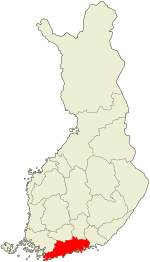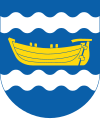Nylandia
|
Uusimaa – Nyland Uudenmaan maakunta Nylands landskap |
|||
|---|---|---|---|
| Region | |||
|
|||
 Uusimaa on a map of Finland |
|||
| Country | Finland | ||
| Historical province | Uusimaa | ||
| Government | |||
| • Regional Mayor | Ossi Savolainen | ||
| • President of the Council | Eero Heinäluoma (SDP) | ||
| Area | |||
| • Total | 9,567.99 km2 (3,694.22 sq mi) | ||
| Population (31.12.2016) | |||
| • Total | 1,638,469 | ||
| • Density | 180,1/km2 (4,660/sq mi) | ||
| Time zone | EET (UTC+2) | ||
| • Summer (DST) | EEST (UTC+3) | ||
| ISO 3166 code | FI-18 | ||
| NUTS | 181 | ||
| - Nominal GDP(2016) | €80 billion | ||
| - Nominal GDP Per capita(2016) | €50,000 | ||
| Regional bird | Blackbird | ||
| Regional fish | Zander | ||
| Regional flower | Windflower | ||
| Regional animal | European hedgehog | ||
| Regional stone | Hornblende | ||
| Website | uudenmaanliitto.fi | ||
Uusimaa or Nyland (Finnish: [ˈuːsimɑː]; Swedish: [ˈnyːland]; both names mean “new land”) is a region in Finland. It borders the regions Southwest Finland, Tavastia Proper, Päijänne Tavastia and Kymenlaakso. Finland’s capital Helsinki (its largest city) and its second largest city Espoo are both located centrally in Uusimaa, making it by far the most populous region.
Uusimaa was, along with the rest of Southern and Western Finland, held by the Kingdom of Sweden from the 12th or 13th century. The coastal Uusimaa had earlier been sparsely populated, mostly by Tavastians, but was from the 12th century populated by Swedish settlers, mostly from Hälsingland, and Swedish-speaking villages came up near the mouths of Vantaanjoki and Keravanjoki. The Swedish placenames of Uusimaa date back to this period. However, there are traces of the older Tavastian placenames left in some names, like Konala which likely derives older name Konhola.
The names Uusimaa and Nyland mean “new land” in English. The Swedish-language name Nyland appears in the documents from the 14th century. The Finnish-language name Uusimaa appears for the first time in 1548 as Wsimaa in the first translation of the New Testament to Finnish by Mikael Agricola.
...
Wikipedia


